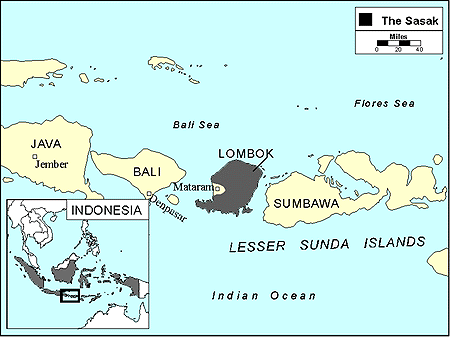|
|
Prayer Profile
The Sasak of Indonesia
![[IMAGE]](../images/0033.jpg) The small Indonesian island of Lombok is the home of more than two million Sasak. Lombok, one of the Lesser Sunda Islands, is located between the islands of Bali and Sumbawa.
The small Indonesian island of Lombok is the home of more than two million Sasak. Lombok, one of the Lesser Sunda Islands, is located between the islands of Bali and Sumbawa.
The Sasak have long been classified into two categories: the "Wetu Telu" (traditional Sasak), and the "Waktu Lima" (strongly Islamic Sasak). For many years, the island was divided into a number of warring Sasak princedoms. This eventually resulted in the Balinese conquest of Lombok, which reduced the Sasak to servitude.
In 1894, the Dutch landed in Lombok and liberated the Sasak from the Balinese. However, this caused the division between the Sasak natives to become even more pronounced. Dutch-appointed Sasak administrators were usually Waktu Lima, and this provoked the Wetu Telu.
What are their lives like?
A central plain running west to east divides the mountainous island of Lombok. While some of the Sasak live in the mountains, most are concentrated in the fertile central plains of the island.
Most of the Sasak are wet-rice farmers. They typically use plows drawn by water buffalo or oxen, and then harvest the crops by hand. Soybeans, maize, sweet potatoes, and coconuts are grown for subsistence; while rice, coffee, tobacco, peanuts, and onions are grown for sale.
A number of the Sasak work as petty traders. Small shops run by wandering peddlers are common in most villages. Part-time and seasonal specialists such as potters, basket makers, or blacksmiths can also be found working in most village markets.
Sasak villages range from several hundred to as many as 15,000 inhabitants. The marketplace and an Islamic mosque are usually located in the center of town. Clusters of homes commonly surround the main village road, and fields separate villages from each other. Houses typically have one or two rooms, thatched roofs, no windows, and are built on platforms of packed earth. Bamboo frames support walls of bamboo, earth, and woven grass or palm leaves. Modern houses are made of wood or concrete and have iron roofs. They usually contain several rooms and a few windows.
The social system of the Sasak is composed of three levels, with two levels for the aristocracy and one for commoners. Nobles and commoners often live in segregated neighborhoods.
While both men and women work as farm laborers, men are basically responsible for clearing the land, building and repairing irrigation works, guarding the crops, plowing, and building houses. Women prepare the food and tend to the household duties.
Most marriages are monogamous. The young people are free to choose their mates, and marriages between cousins are common.
Traditional arts include making musical instruments such as gongs, drums, and wooden xylophones. Dance dramas, shadow-puppet plays, and Islamic songs and dances are also cultural favorites.
What are their beliefs?
The Sasak are 99.9%
Muslim.
Most of the villages have mosques and many also have religious schools.
A small number of Sasak in isolated villages still embrace traditional ancestor cults. They celebrate "life crisis ceremonies" and agricultural feasts. Illnesses are often attributed to evil spirits, sorcery, or supernatural retaliation. However, such beliefs are less prevalent today than in the past, and are slowly being replaced by Islamic practices.
What are their needs?
Although there are five missions agencies working among the Sasak, there are less than 500 believers on the island. Seventy-seven percent of the population (nearly 1.8 million) has never heard the Gospel. Only portions of the Bible have been translated into the Sasak language.
Prayer Points
- Pray against the spiritual principalities and powers that have kept the Sasak bound for many generations.
- Ask the Lord to raise up laborers who understand the Muslim culture and who can effectively take the Gospel to the Sasak.
- Pray that the Sasak will become dissatisfied with Islam and will begin searching for the Truth.
- Ask God to strengthen, encourage, and protect the small number of Sasak believers.
- Pray that God will raise up qualified linguists to complete translation of the Bible into Sasak.
- Ask the Holy Spirit to soften the hearts of these Muslims towards Christians so that they will be receptive to the Gospel.
- Pray that the Holy Spirit will multiply the effectiveness of the Jesus film in Lombok.
- Ask the Lord to raise up a strong local church among the Sasak.

Statistics
Latest estimates from the World Evangelization Research Center.
THE PEOPLE
- People name: Sasak
- Country: Indonesia
- Their language: Sasak
- Population:
- Largest religion:
- Christians: <1%
- Church members: 459
- Scriptures in their own language: Portions
- Jesus Film in their own language: None
- Christian broadcasts in their own language: Available
- Mission agencies working among this people: 5
- Persons who have heard the Gospel: 528,200 (23%)
- Persons who have never heard the Gospel: 1,766,300 (77%)
THEIR COUNTRY
- Country: Indonesia
- Population:
- Major peoples in size order:
- Major religions:
- Number of denominations: 113
© Copyright 1997
Bethany World Prayer Center
This profile may be copied and distributed without obtaining permission
as long as it is not altered, bound, published
or used for profit purposes.
![[HOME BUTTON]](../graphics/home.jpg)
![[CALENDAR BUTTON]](../graphics/calico.jpg)
![[LIST BUTTON]](../graphics/listico.jpg)
[Home]
[Calendar]
[Country List]
|